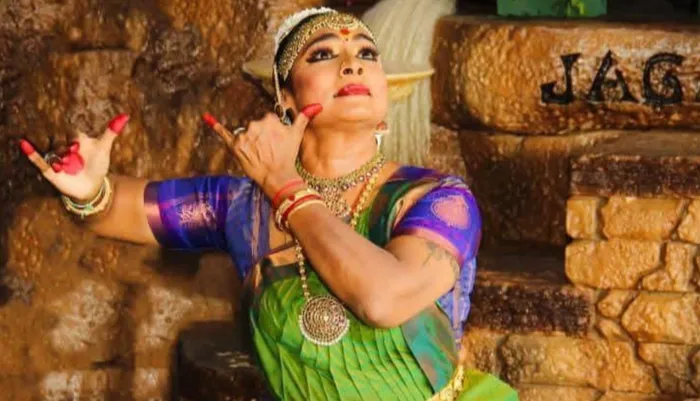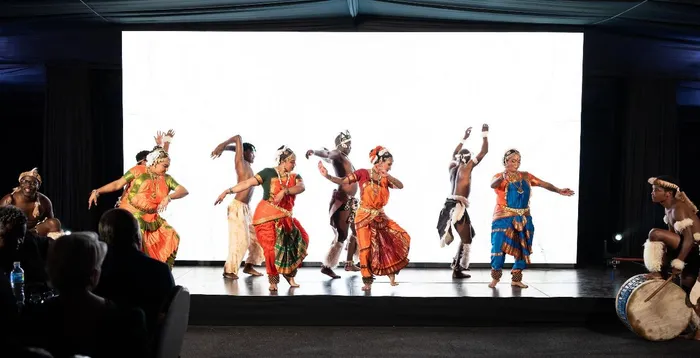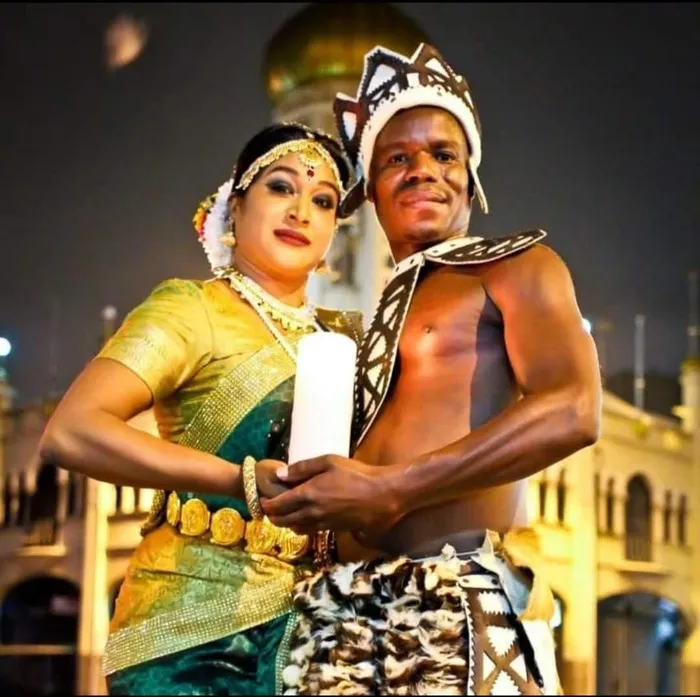Beyond ballet: The call for Bharathanatyam's recognition in local education
"It deserves its rightful place in our schools and our national stages with state funding"

Verushka Pather.
Image: Supplied
Dr Devi Rajab argues that Bharatha Natyam deserves equal recognition, funding and inclusion in South African schools alongside Western art forms like ballet.
THE 2000-year-old South Indian classical dance form, Bharatha Natyam, deserves its rightful place in our schools and our national stages with state funding. Sadly, only Western art forms such as ballet are regarded as valid or worthy.
“It is time Bharatha Natyam is recognised and appreciated by people outside of the Indian community,” says Dr Devi Rajab, an award-winning columnist, academic and thought leader.
She was speaking at the Bharatha Natyam arangetram (debut public performance) in Durban of a young student of the celebrated dance form.
Bharatha Natyam, she said, remained largely unrecognised outside the Indian community in South Africa.
“It is a troubling reality that in many of our elite private schools – particularly those steeped in colonial legacies – ballet continues to be upheld as the gold standard of artistic expression.
“It is considered ‘classical, elegant and culturally enriching’. But Bharatha Natyam is often ignored, not funded, and not celebrated in school assemblies. It is not considered worthy of school colours or cultural recognition.
“This erasure is not innocent. It reflects a narrow, Eurocentric lens that continues to define what counts as art, and what is seen as ethnic, folkloric or irrelevant.
“It is a severe problem when a few young Indian pupils especially in private schools, commit to learning Bharatha Natyam with full passion and reverence, and yet their peers receive praise and institutional recognition for ballet or contemporary dance, while your art, your heritage, Bharatha Natyam, is rendered invisible. This creates a silent anguish. A quiet identity crisis,” said Rajab.
She said children should never be made to feel that their culture was “a second-tier identity” or that their history is too foreign to matter.
“And yet this is what one-dimensional thinking does. It silences multiplicity. It narrows the imagination. And in doing so, it robs us all.
“In a truly post-apartheid South Africa, our schools and institutions must reflect the diversity of our society. We cannot continue to uphold only Western art forms as valid or worthy. We must make room on the stage for all our stories, all our rhythms, all our children.
“Bharatha Natyam, like ballet, is classical. It is demanding. It is intellectual. It is spiritual. And it deserves its rightful place in our schools, our funding frameworks, our national stages,” she added.

The Surialanga Dance Company performing at Oceans Umhlanga Roof wetting event.
Image: Supplied
Leading dancers and teachers weigh in on this cultural inequality and propose solutions: for greater inclusion Suria Govender, professor at Stellenbosch Business School and artistic director at Surialanga Dance Company, said that Bharatha Natyam was not supported by state funding.
“I believe that Bharatha Natyam will not take its rightful place as one of South Africa’s national dance forms if it is not supported by state funding as part of the social cohesion project. This should start in early education and schools, so children are encouraged to see themselves in the other no matter what race they belong to.
“There are a number of schools which continue to teach Bharatha Natyam in primarily-segregated areas simply because the national plan regarding integration has succeeded only to some degree. As a result, children of Indian descent are largely exposed to this form,” she said.
“The Surialanga Dance Company’s education programme has included a conscious inclusion of dancers and dance forms from different race groups over its more than 40-year history. As we are located in KZN and the majority of the people speak isiZulu, the language and dance feed our form of intercultural dance.
"In the last few months, Surialanga was given tremendous support and validation by thousands in the multiracial audiences hosted by the Brahma Kumaris and Oceans Umhlanga roof-wetting event.
"This says that South Africa owns and celebrates its multicultural identity so many years after the advent of democracy.
“As a ballet, contemporary and Bharatha Natyam dancer, I agree with Dr Rajab that Western art forms such as ballet are regarded as valid or worthy to the exclusion of others.
"She added that some indigenous forms were sometimes supported, but not on a consistent basis. If our national identity and performing arts are to be recognised as uniquely multicultural which it is, government support through curriculum changes and funding must be given to the development of Bharatha Natyam and indeed other dance forms in our country.
"In the context of the political upheaval in our country, some government support of the arts to celebrate our multicultural identity as South Africans will be in order,” said Govender.

Sivani Chinappan Moodley and Sibusiso Ndebele.
Image: Supplied
Verushka Pather, artistic director at Natya Ananda Fine Arts Academy and Bharatha Natyam dancer for 40 years, said she agreed with Rajab. “
Bharatha Natyam for many of us, is our very breath, a life force that governs our beings. If our narrative is purely the discipline, dedication and devotion of a classical Sampradaya or lineage, and we live by these principles, this means that we are fulfilling the expectation of a renowned classical art.
“I believe and see it as an equal to all other Western and classical music and dance. It is for the individuals in power that governs financial support, acknowledgment of the various genres that need to understand that the Indian classical arts play a pivotal role in contributing to global art and the evolution of art, both locally and internationally.
“The respected Dr Devi Rajab has a powerful voice. Her message today echoes the voice of many students, practitioners, gurus and performing artists. Let this be a message that leads us to our rightful space of acknowledgement,” said Pather.
Sivani Chinappan Moodley, a Bharatha Natyam dancer for 22 years, said this had not been the first time this discussion had surfaced.
“This is not a new dish brought to the buffet of South Africa. Professor Suria Govender and Jayasperi Moopan made great efforts in making this art form inclusive and accessible to all South Africans. However, they received backlash from conservative individuals who felt this art form must be preserved and reserved for a selected few because it is a sacred traditional art form. One of the Surialanga community development initiatives employs trained Bharatha Natyam teachers to share this art form with indigent and non-Indian communities throughout KZN.
“The reality is that more people outside the Indian community are interested in learning and performing Bharatha Natyam. Social media has non-Indians the world over performing with such bakthi (devotion), while many Indian families in South Africa have to beg their children to attend weekly Bharatha Natyam lessons.
"In India, the art form was first shared with international students by Rukmini Devi Arundale, founder of the renowned and much-respected Kalakshetra in Chennai. Before her courageous move, Bharatha Natyam was limited to caste and social class," said Moodley.
“Regarding greater exposure and state funding, I have collaborated with Sadta (South African Dance Teachers Association) to get Bharatha Natyam teachers and schools registered, and the idea was welcomed unreservedly by Western dance teachers. The intention is to create a database, engage with the Department of Basic Education to include Bharatha Natyam in the arts and culture curriculum, and employ qualified Bharatha Natyam specialists to contribute to the development of the curriculum.
"Unfortunately, Bharatha Natyam teachers haven’t joined or registered their schools as yet, and it’s almost a year since the initiative,” she said.
“I believe Bharatha Natyam is a recognised and respected art form. However, audiences have changed and subsequently value the dance style differently. If Bharatha Natyam is a ‘dying art form’, who do we blame?” asked Moodley.
Manesh Maharaj, a classical Kathak dancer for 35 years, said all forms of Indian dance should be respected as much as Western dance.
"Indian classical dance forms like Kathak and Bharatha Natyam undoubtedly deserve the same respect as classical ballet.
“These art forms also need to be offered to pupils as part of the school curriculum starting from primary school, which are crucial years in a dance student’s journey.
“We have many Indian classical dance teachers who are qualified to teach dance in schools. As a professional dancer myself, I wish I had started learning dance earlier, but I could only start my training after matric when I had to leave South Africa and travel to India to learn the art of Kathak,” said Maharaj.